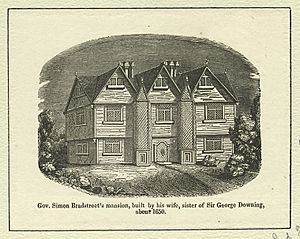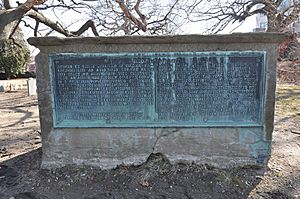Simon Bradstreet facts for kids
Quick facts for kids
Simon Bradstreet
|
|
|---|---|
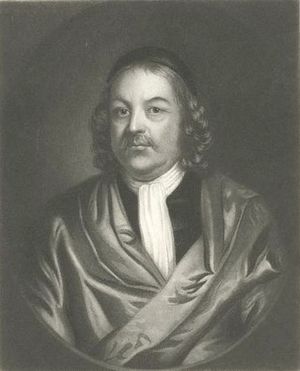
Engraving based on a painting in the Massachusetts State House
|
|
| 20th and 21st Governor of the Massachusetts Bay Colony | |
| In office 1679–1686 |
|
| Preceded by | John Leverett |
| Succeeded by | Joseph Dudley (as President of the Dominion of New England) |
| In office May 24, 1689 – May 16, 1692 |
|
| Preceded by | Sir Edmund Andros (as Governor of the Dominion of New England) |
| Succeeded by | Sir William Phips (as Governor of the Province of Massachusetts Bay) |
| Deputy Governor of Massachusetts Bay | |
| In office 1678–1679 |
|
| Governor | John Leverett |
| Preceded by | Simon Symonds |
| Succeeded by | Thomas Danforth |
| Secretary of Massachusetts Bay | |
| In office 1630–1636 |
|
| Preceded by | None, position established |
| Succeeded by | Increase Nowell |
| Member of the Council of Assistants | |
| In office 1630–1678 |
|
| Governor |
List
John Endecott
(five times) John Winthrop (four times) Thomas Dudley (four times) John Haynes Henry Vane the Younger Richard Bellingham (three times) John Leverett |
| In office 1679–1686 |
|
| Governor | Himself |
| In office 1689–1692 |
|
| Governor | Himself |
| United Colonies Commissioner for Massachusetts Bay | |
| In office 1644–1644 |
|
| In office 1648–1661 |
|
| In office 1663–1664 |
|
| In office 1669–1672 |
|
| In office 1674–1675 |
|
| In office 1677–1677 |
|
| Personal details | |
| Born | baptized March 18, 1603 Lincolnshire, England |
| Died | March 27, 1697 (aged 93) Salem, Province of Massachusetts Bay |
| Spouse | Anne Dudley Bradstreet |
| Signature | |
Simon Bradstreet was an important leader in the early days of the Massachusetts Bay Colony. He was born in England around 1603 or 1604. In 1630, he sailed to Massachusetts with the Winthrop Fleet. He was involved in the colony's government for many years.
Bradstreet became the last governor of the Massachusetts Bay Colony in 1679. He also served as a diplomat, representing the colony to the English king. He was known for being fair and for trying to find peaceful solutions. He supported freedom of speech and believed in working with the king, Charles II of England.
Simon Bradstreet was married to Anne Bradstreet, who was the daughter of another important leader, Thomas Dudley. Anne Bradstreet became New England's first published poet. Simon Bradstreet was also a successful businessman. He lived to be 93 years old, which was very old for his time!
Contents
Early Life and Moving to America
Simon Bradstreet was born in a small village in England. His father was a church leader who did not agree with all the rules of the official church. This meant young Simon grew up with strong Puritan beliefs.
At age 16, Simon went to Emmanuel College, Cambridge for two years. Later, he worked for a powerful English nobleman, helping Thomas Dudley. In 1628, Simon married Dudley's daughter, Anne. She was only 16 at the time.
In 1628, Thomas Dudley and others started the Massachusetts Bay Company. Their goal was to create a Puritan colony in North America. Simon Bradstreet joined them. In April 1630, the Bradstreets, Dudleys, and Governor John Winthrop sailed to Massachusetts. They helped found Boston, which became the capital of the Massachusetts Bay Colony.
Life in the Massachusetts Bay Colony
After arriving, Simon Bradstreet first lived in Newtowne, which is now Cambridge. He later moved to Ipswich and then helped found Andover in 1648. Sadly, his home in Andover burned down in 1666.
Bradstreet was a smart businessman. He bought and sold land and invested in ships that traded along the coast. He even owned more than 1,500 acres of land when he died. He also owned two enslaved people, a woman named Hannah and her daughter Billah.
If ever two were one, then surely we;
If ever man were loved by wife, then thee;
If ever wife was happy in a man,
Compare with me, ye women, if you can.
I prize thy love more than whole mines of gold,
Or all the riches that the East doth hold.
Simon Bradstreet was deeply involved in the colony's government. He became the colonial secretary in 1630 and held that job until 1644. He was known for being fair. He argued against laws that punished people for speaking out against the government. He also spoke out against the terrible Salem Witch Trials in 1692.
He served as a commissioner for Massachusetts in the New England Confederation. This group helped the New England colonies work together, especially for defense. Bradstreet was often chosen as an assistant to the governor. In 1678, he became the deputy governor under John Leverett.
Bradstreet often preferred peaceful solutions. He was against fighting in a French dispute in the 1640s. He also spoke against attacking the Dutch colony of New Netherland during a war between England and the Dutch (1652–1654).
Diplomatic Missions
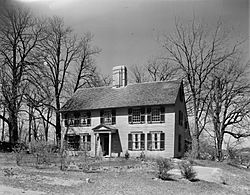
Bradstreet went on several important trips to deal with other settlers, English colonies, and the Dutch. In 1650, he went to Hartford, Connecticut. There, he helped create the Treaty of Hartford (1650). This treaty set the border between the English colonies and New Amsterdam (a Dutch colony). He also helped bring settlers in York and Kittery under Massachusetts' control.
After Charles II of England became king again in 1660, the colony worried about keeping its special rights. Bradstreet led a group to discuss these rights and show loyalty to the king. Bradstreet and John Norton traveled to London to deliver a letter to the king.
King Charles renewed the colony's charter, but he added some conditions. He wanted the colony to allow more religious freedom, including for the Church of England and Quakers. Bradstreet believed it was important to follow the king's wishes to keep the colony safe. However, some leaders in the colony disagreed. They wanted to strongly protect the colony's rights. This disagreement caused tension in Massachusetts for many years.
Becoming Governor
In 1679, Governor John Leverett died. Simon Bradstreet, as deputy governor, took his place. Bradstreet became the last governor under the colony's original charter.
During his time as governor, a royal agent named Edward Randolph was in the colony. Randolph tried to enforce the Navigation Acts. These were English laws that controlled trade and made some types of trade illegal for the colony.
Many people in Massachusetts, especially merchants, did not like these laws. Juries often refused to punish ships that broke the rules. Bradstreet tried to work with Randolph, but it was difficult. The colony's leaders eventually decided to create their own ways to enforce the trade laws. However, Bradstreet did not fully put these new laws into action.
Randolph kept complaining to the king about the colony's resistance. The king's advisors, the Lords of Trade, told Massachusetts to give its agents more power to negotiate changes to the charter. If they didn't, the charter could be taken away. The colony refused to give in. Because of this, the king officially canceled the Massachusetts charter on October 23, 1684.
The Dominion and Bradstreet's Return
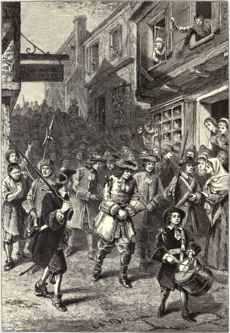
In 1684, King Charles II created the Dominion of New England. This was a large new government that combined several New England colonies. Bradstreet's brother-in-law, Joseph Dudley, was put in charge in 1686. Bradstreet was offered a job in this new government but refused.
Later, Sir Edmund Andros became the governor of the Dominion. Many people in Massachusetts disliked Andros. He took away land titles and used Puritan church buildings for English church services. His rule was very unpopular.
People in Boston started planning to revolt against Andros in early 1689. News of the Glorious Revolution in England, where William and Mary II took the throne, reached Boston. This news encouraged the colonists. On April 18, 1689, a large crowd formed in Boston. Simon Bradstreet and other former leaders wrote a letter to Andros, asking him to surrender to calm the crowd. Andros surrendered and was later sent back to England.
After Andros was arrested, a "council of safety" was formed, with Bradstreet as its leader. The council decided to bring back the old government under the original charter. Simon Bradstreet became governor again and was re-elected every year until 1692. He had to deal with people who opposed the old rules and with ongoing conflicts with Native Americans on the northern frontier. Bradstreet supported military actions led by Sir William Phips against French territories in 1690.
In 1691, King William and Queen Mary issued a new charter for the Province of Massachusetts Bay. They appointed Sir William Phips as the first governor. Bradstreet was offered a position on Phips' council but declined.
Simon Bradstreet died at his home in Salem on March 27, 1697. He was 93 years old. Because of his very long life and wisdom, he was called the "Nestor of New England."
Family Life
Simon Bradstreet was buried in the Charter Street Burying Ground in Salem. His first wife, Anne, was a famous poet. She wrote poems that showed her deep love for her husband. Anne Bradstreet died in 1672. They had eight children together, and seven of them lived past infancy. Their children included Dudley and John. In 1676, Simon Bradstreet married Ann Gardner, who was a widow from Salem.
Images for kids


